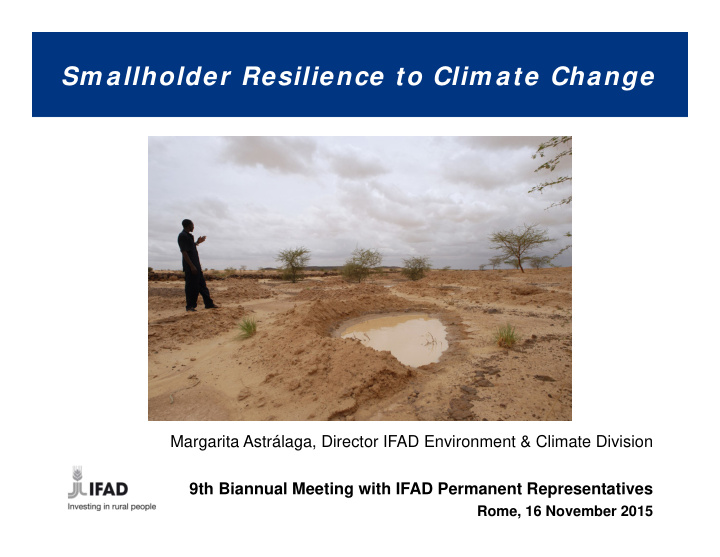



Sm allholder Resilience to Clim ate Change Margarita Astrálaga, Director IFAD Environment & Climate Division 9th Biannual Meeting with IFAD Permanent Representatives Rome, 16 November 2015
AGRICULTURE and CLIMATE CHANGE Agriculture is part of the problem AND part of the solution 500 million smallholder farms produce up to 80% of food in developing countries Agriculture, forestry and other land use – 25% of global greenhouse gas emissions
CLIMATE CHANGE and RESILIENCE The capacity of a person or household to deal with change, withstand and recover from RESILIENCE disturbances from weather-related events The capacity to avoid poverty in the face of climate-induced shocks and stresses
Waiting for the Rain VIDEO Burkina Faso –
ADAPTATION FOR SMALLHOLDER AGRICULTURE PROGRAMME (ASAP) Worldwide largest climate change adaptation programme for smallholder farmers Most concrete and visible flagship programme on agriculture adaptation Integrates climate resilience actions into IFAD investment programmes Centrepiece of a change management process
ASAP in a nutshell Operational since September 2012 US$ 366 million from 10 bilateral donors Integrates adaptation actions into IFAD investments (28 out of 43 ASAP grants approved) 1 US$ of ASAP financing supports climate resilience of up to 6 US$ from IFAD & other sources UNFCCC Momentum for Change Award (2013)
Examples from IFAD’s Adaptation for Smallholder Agriculture Programme Gernot Laganda, Lead Technical Specialist
How do ASAP investments help smallholder farmers increase their resilience? 1) By analyzing new and emerging risks 2) By providing access to technology, information and financing for climate risk management 3) By building scale mechanisms and pathways for sustainable landscape management
Example Nicaragua: Analyzing climate change impacts on coffee Suitability of coffee growing areas by 2050, based on climate models
Example Nicaragua (cont.): Prioritizing investments in adaptation & resilience Coffee agroforestry Intercropping (banana/cocoa) Access to weather information and disease monitoring Improved water storage
Example Nicaragua (cont.): Building pathways and mechanisms for scale Policy engagement on long-term strategies for coffee & cocoa in Nicaragua Training of cooperatives on sustainable management of landscapes
Example Viet Nam: Analyzing climate change impacts on rice farming Mekong River Delta Sea level rise projections : • 17 cm by 2030 • 30 cm by 2050 • Rice growing area: minus 13% Source: IFPRI, 2011
Example Viet Nam (cont.): Prioritizing investments in adaptation & resilience Salinity monitoring Salinity-resistant catfish breeding Community-based crop trials Diversification of income streams
Example Viet Nam (cont.): Building pathways and mechanisms for scale Evidence-based allocation of provincial budgets Integrative knowledge management system, combining community and academic research Policy-relevant impact assessments
ASAP at scale – which difference are we making? Indicator of success Programmed to date Final target (after 28 ASAP (after 43 ASAP investments) investments) Smallholder farmers with 5.6 million 8 million increased resilience Hectares managed under 1.5 million 1 million climate resilient practices Households, production and 99,000 households 100,000 households processing facilities with (plus 2560 facilities) increased water availability US$ value of rural US$ 54 million US$ 80 million infrastructure protected (+ 625 km of roads) International and country 49 dialogues 40 dialogues dialogues on climate issues
The case of Mali Philippe Remy, Country Programme Manager
Project scope and objectives • Project: Fostering Agricultural Productivity in Mali (PAPAM) • IFAD investment: US$ 32 mill • ASAP co-financing: US$ 10 mill • Objective: To increase the resilience of smallholder farmers in the Kayes and Sikasso regions
Project area and vulnerability to climate change • Reduced and unpredictable rainfall • Increase in temperature • Increase in magnitude and frequency of extreme weather events Rainfall trends (1994-2013) in mm per decade
Component 1: Technology transfer Biogas technology: Phase I: 100 fixed domes and 45 flexible Phase II: Scaling up within a national strategy
Component 2: Community-based adaptation - Participatory planning - Implementation of local adaptation plans - Better access to weather information
Component 3: Programmatic approach and sectorial monitoring - Support to participatory policy dialogue - Innovative Multidimensional Poverty Assessment Tool
Climate Resilience in IFAD: LOOKING AHEAD ASAP phase 2 – broadening from grants to loans Accreditation to the Green Climate Fund High level policy engagement in UNFCCC COP21 Securing additional funding from the Global Environment Facility (GEF) Social, Environmental and Climate Assessment Procedures (SECAP) fully rolled out Environment & climate change 100% mainstreamed by 2018
THANK YOU!
Recommend
More recommend